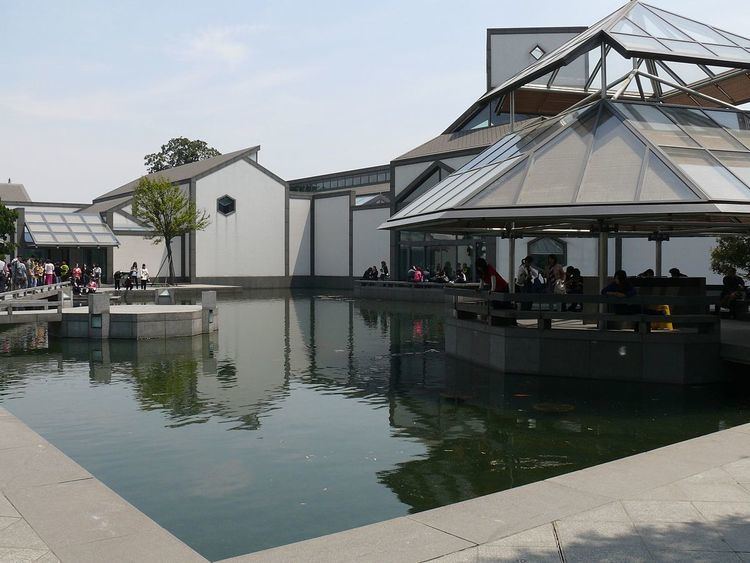Architect I. M. Pei | ||
 | ||
Hours Open today · 9AM–5PMSunday9AM–5PMMondayClosedTuesday9AM–5PMWednesday(Qingming Festival)9AM–5PMHours might differThursday9AM–5PMFriday9AM–5PMSaturday9AM–5PMSuggest an edit Architecture firm Pei Partnership Architects Similar Taipingtianguo Zhongwang Mansion, Humble Administrator's Garden, Lion Grove Garden, Ningbo Museum, Shanghai Museum | ||
Im pei s suzhou museum
The Suzhou Museum (Chinese: 蘇州博物館; pinyin: Sūzhōu Bówùguǎn) is a museum of ancient Chinese art, ancient Chinese paintings, calligraphy, and handmade crafts, situated in Suzhou, Jiangsu, China. Admission is free. The Suzhou Folk Museum is located in the Bei family ancestral temple near Lion Grove Garden, the Folk Branch of Suzhou Museum is the first professional museum which specializes in displaying urban local traditions.
Contents
- Im pei s suzhou museum
- Suzhou museum project for art and business
- History
- Current building
- Collections
- District
- Design
- References
Suzhou museum project for art and business
History
Current building
The current building of Suzhou Museum was designed by Pritzker Prize-winning Chinese-American architect I.M. Pei in association with Pei Partnership Architects. The structural engineer for this project was Leslie E. Robertson Associates. Construction of this building started in 2002. It was inaugurated on October 6, 2006.
The multi-year process of designing, building and inaugurating the new museum was chronicled in PBS's American Masters television documentary series in an 2010 episode entitled "I.M. Pei: Building China Modern".
Collections
The museum has a display area of 2,200 square meters. It has more than 15,000 pieces in its collections. Most are ancient paintings and calligraphy, ceramics, crafts, unearthed relics and revolution relics. It also possesses more than 70,000 books and documents, and over 20,000 rubbings of stone inscriptions. The collection of paintings and calligraphy includes works of masters from Song Dynasty to Ming and Qing dynasties.
District
The dis play part the Folk Brunch of Suzhou Museum falls into three districts, which is composed of Local Festival Hall, Lucky Traditions Hall and Children Rearing Hall.
It took quite a long time for the forming and development of local festival, while traditional festivals in our country came into being and developed along with agricultural civilization. Suzhou is a land flowing with milk and money with wild climate and distinctive four seasons and it has developed rice agriculture and abundant water resources. Therefore, festivals and cultural traditions in Suzhou are characterized water and unique local flavor. The key displays include: Sightseeing in Shangtang, Roll the immortal, The Dragon Boat Festival, Mid-autumn Day, Appreciating Lotus Festival, Kitchen Models and Dragon and Phoenix lanterns.
Lucky traditions reflect people's ideas of avoiding bad omen and wishing good luck and longing for longevity and happiness. Traditions in Suzhou are extremely colorful and wonderful and reflect in all aspects such as faith, etiquette and production and living, representing Suzhou people's good yearning and pursuits. The key displays include: Worship Valiant General, Twelve Months Flowers'Goddess, Marriage God, Burning Incense in Dongyue Temple and good fortune, official pay and longevity.
Suzhou has different kinds of children rearing traditions since a long time ago. A series of rituals and affairs need to be finished at one's birth, full-month and first-year, which are important components of local traditions, reflecting expectations on offspring from family and society. This series of displays relatively focus on characteristics of children rearing traditions in Suzhou in past times. Not only did it shoe our country's tradition of emphasizing on human relations, it also reflected people in Suzhou attached great importance on culture and education. The key displays include: Full Month Birth, Baby Draw Lots, Seeking Godparent, and Uncle Sending to the school and Weighing People in Summer Begins.
Design
I.M. Pei has designed museums, college buildings, commercial centers and many skycrapers. With his innovation and creativity, he built many extraordinary buildings all over the world, in Canada, France, Germany, Australia, Japan, Singapore, Iran and Taiwan. In 1983, Pei was awarded the Pritzker Architecture Prize. Even at the stage, he continues to pursue his dreams and surpass himself by making his design highly monumental than ever. He is truly an outstanding architect by trade.
The new Suzhou Museum is said to be the last design of Mr. I.M.Pei in his career. Therefore, not only does it become a monumental design building in Suzhou, but also a significant construction, merging the traditional Chinese architectural design with the future. It enhances the protection of Suzhou cultural heritages, and enables Suzhou Museum to turn on a new page.
